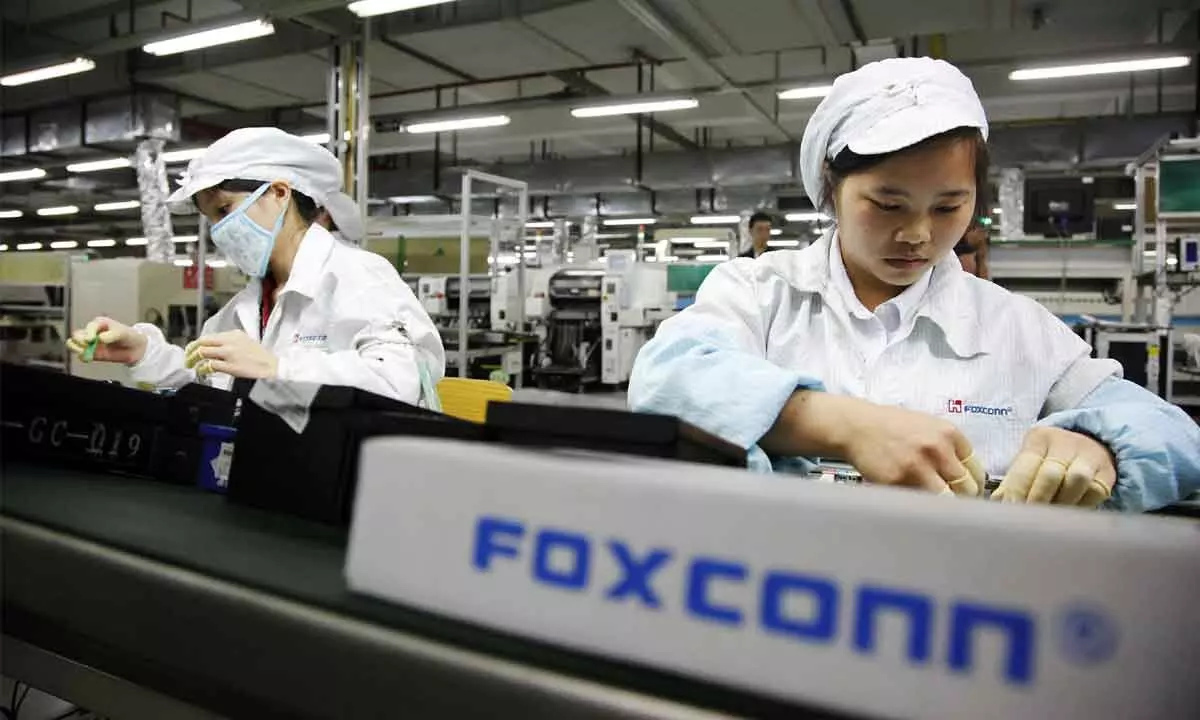Foxconn Beats Estimates with Record Fourth-Quarter Revenue
In a stellar performance that underscores its pivotal role in the global technology supply chain, Foxconn Technology Group, the world’s largest contract electronics manufacturer, has reported record revenue for the fourth quarter. The company’s robust performance exceeded market expectations, driven by a surge in demand for consumer electronics, innovative diversification strategies, and resilience in the face of global economic challenges.

A Record-Setting Quarter
Foxconn, officially known as Hon Hai Precision Industry Co., reported revenue of NT$1.97 trillion (approximately $64 billion) for the fourth quarter, a significant increase from the NT$1.85 trillion reported in the same period last year. This marks the company’s highest-ever quarterly revenue and a year-over-year growth of 6.5%. The robust performance has been attributed to strong sales of premium smartphones, steady demand for cloud and network solutions, and the company’s expanding footprint in electric vehicles (EVs).
The revenue beat analysts’ estimates, which had projected NT$1.92 trillion for the quarter. This strong financial performance highlights Foxconn’s ability to navigate supply chain disruptions, labor shortages, and fluctuating global demand effectively.

Drivers of Growth
Foxconn’s record revenue was fueled by several key factors:
1. Strong Demand for Consumer Electronics
As the primary assembler of Apple’s iPhones, Foxconn benefited significantly from strong sales of the iPhone 15 series, particularly in North America and Asia. Despite concerns about a global economic slowdown, premium smartphone models continued to attract buyers, bolstering Foxconn’s revenue.
The company’s diversification of its client base also played a crucial role. Foxconn’s contracts with other major tech players, including Google, Microsoft, and Amazon, for consumer electronics and cloud computing equipment further contributed to its impressive performance.
2. Expansion into Electric Vehicles
Foxconn’s strategic push into the EV market began bearing fruit in the fourth quarter. Collaborations with major automakers and the launch of its own EV platforms have positioned the company as a significant player in this burgeoning industry. Revenue from the EV segment grew by over 20% year-over-year, reflecting increased production volumes and new partnerships.
3. Resilient Supply Chain Management
The company demonstrated remarkable agility in managing supply chain challenges, including semiconductor shortages and logistical bottlenecks. By leveraging its global network of manufacturing facilities and strategic partnerships, Foxconn ensured timely deliveries and minimized disruptions. Its investment in smart manufacturing and automation also enhanced operational efficiency.
4. Geographic Diversification
Foxconn’s expansion into emerging markets, including India, Vietnam, and Brazil, proved to be a significant growth driver. The company’s increased production capacity in these regions not only reduced its reliance on China but also enabled it to tap into local markets and benefit from favorable government policies.

Financial Highlights
- Net Income: Foxconn reported a net income of NT$51.3 billion ($1.66 billion), a 9% increase compared to the previous year.
- Gross Margin: The company’s gross margin improved to 7.8%, up from 7.5% in the same quarter last year, driven by cost optimization initiatives and higher-margin product lines.
- Earnings Per Share (EPS): EPS rose to NT$3.71, exceeding analysts’ expectations of NT$3.58.

Challenges and Risks
While the fourth quarter was a resounding success, Foxconn faces several challenges that could impact its future performance:
1. Geopolitical Tensions
Rising tensions between the United States and China pose a risk to Foxconn’s operations. The company’s heavy reliance on China for manufacturing and as a key market makes it vulnerable to policy changes and trade restrictions.
2. Labor and Regulatory Issues
Foxconn has faced scrutiny over labor practices in its factories. Recent protests at its Zhengzhou plant, the largest iPhone assembly facility, highlighted worker dissatisfaction over wages and COVID-19-related restrictions. While the company has taken steps to address these concerns, any recurrence could disrupt production and tarnish its reputation.
3. Supply Chain Vulnerabilities
Despite its resilience, Foxconn remains susceptible to global supply chain disruptions. Semiconductor shortages, shipping delays, and raw material price fluctuations could affect its ability to meet demand.
4. Intense Competition
The contract manufacturing industry is becoming increasingly competitive, with rivals such as Pegatron, Wistron, and Luxshare Precision vying for market share. Foxconn’s ability to maintain its leadership position will depend on continuous innovation and operational excellence.

Strategic Initiatives for 2025 and Beyond
To sustain its growth trajectory, Foxconn is focusing on several strategic initiatives:
1. Investments in Automation and AI
The company is ramping up investments in automation and artificial intelligence (AI) to enhance productivity and reduce labor dependence. Its “smart factory” initiatives aim to streamline operations and improve quality control.
2. Expansion in India and Southeast Asia
Foxconn plans to significantly increase its production capacity in India and Southeast Asia. The company has announced investments worth billions of dollars in new manufacturing facilities, which will not only support global demand but also cater to the rapidly growing local markets.
3. Growth in Electric Vehicles
Foxconn’s ambitious EV strategy includes partnerships with automakers like Fisker, Stellantis, and BYD. The company’s MIH (Mobility in Harmony) platform aims to provide an open EV ecosystem, attracting a diverse range of collaborators.
4. Diversification into Healthcare and Semiconductors
Foxconn is exploring opportunities in healthcare technology and semiconductor manufacturing. These high-growth sectors align with global megatrends and have the potential to become significant revenue streams.

Market Reaction
Following the announcement of its record fourth-quarter revenue, Foxconn’s stock rose by 4% on the Taiwan Stock Exchange, reflecting investor confidence in the company’s growth prospects. Analysts have revised their price targets upward, citing the company’s strong fundamentals and strategic initiatives.
Conclusion
Foxconn’s record fourth-quarter revenue underscores its resilience and adaptability in a rapidly evolving global landscape. By leveraging its strengths in consumer electronics, expanding into new markets, and pursuing innovative strategies, the company has solidified its position as a leader in the technology supply chain.
However, navigating geopolitical risks, labor challenges, and intense competition will require sustained focus and strategic agility. As Foxconn continues to diversify its operations and invest in future growth sectors, its trajectory will be closely watched by investors, competitors, and industry stakeholders alike.









